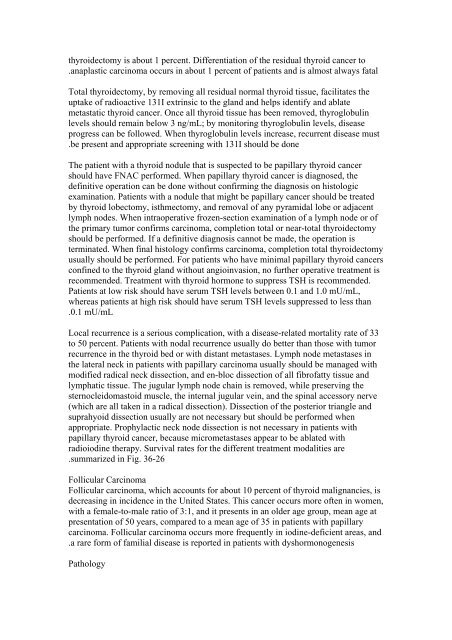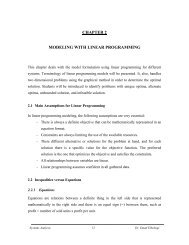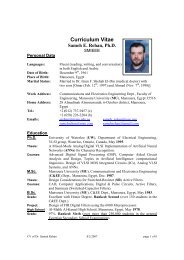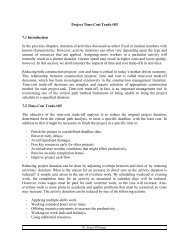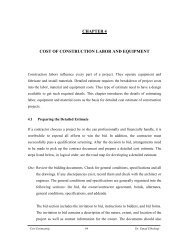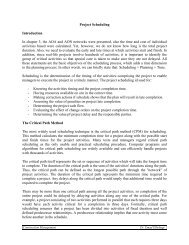Thyroid and Parathyroid
Thyroid and Parathyroid
Thyroid and Parathyroid
Create successful ePaper yourself
Turn your PDF publications into a flip-book with our unique Google optimized e-Paper software.
thyroidectomy is about 1 percent. Differentiation of the residual thyroid cancer to<br />
. anaplastic carcinoma occurs in about 1 percent of patients <strong>and</strong> is almost always fatal<br />
Total thyroidectomy, by removing all residual normal thyroid tissue, facilitates the<br />
uptake of radioactive 131I extrinsic to the gl<strong>and</strong> <strong>and</strong> helps identify <strong>and</strong> ablate<br />
metastatic thyroid cancer. Once all thyroid tissue has been removed, thyroglobulin<br />
levels should remain below 3 ng/mL; by monitoring thyroglobulin levels, disease<br />
progress can be followed. When thyroglobulin levels increase, recurrent disease must<br />
. be present <strong>and</strong> appropriate screening with 131I should be done<br />
The patient with a thyroid nodule that is suspected to be papillary thyroid cancer<br />
should have FNAC performed. When papillary thyroid cancer is diagnosed, the<br />
definitive operation can be done without confirming the diagnosis on histologic<br />
examination. Patients with a nodule that might be papillary cancer should be treated<br />
by thyroid lobectomy, isthmectomy, <strong>and</strong> removal of any pyramidal lobe or adjacent<br />
lymph nodes. When intraoperative frozen-section examination of a lymph node or of<br />
the primary tumor confirms carcinoma, completion total or near-total thyroidectomy<br />
should be performed. If a definitive diagnosis cannot be made, the operation is<br />
terminated. When final histology confirms carcinoma, completion total thyroidectomy<br />
usually should be performed. For patients who have minimal papillary thyroid cancers<br />
confined to the thyroid gl<strong>and</strong> without angioinvasion, no further operative treatment is<br />
recommended. Treatment with thyroid hormone to suppress TSH is recommended.<br />
Patients at low risk should have serum TSH levels between 0.1 <strong>and</strong> 1.0 mU/mL,<br />
whereas patients at high risk should have serum TSH levels suppressed to less than<br />
. 0.1 mU/mL<br />
Local recurrence is a serious complication, with a disease-related mortality rate of 33<br />
to 50 percent. Patients with nodal recurrence usually do better than those with tumor<br />
recurrence in the thyroid bed or with distant metastases. Lymph node metastases in<br />
the lateral neck in patients with papillary carcinoma usually should be managed with<br />
modified radical neck dissection, <strong>and</strong> en-bloc dissection of all fibrofatty tissue <strong>and</strong><br />
lymphatic tissue. The jugular lymph node chain is removed, while preserving the<br />
sternocleidomastoid muscle, the internal jugular vein, <strong>and</strong> the spinal accessory nerve<br />
(which are all taken in a radical dissection). Dissection of the posterior triangle <strong>and</strong><br />
suprahyoid dissection usually are not necessary but should be performed when<br />
appropriate. Prophylactic neck node dissection is not necessary in patients with<br />
papillary thyroid cancer, because micrometastases appear to be ablated with<br />
radioiodine therapy. Survival rates for the different treatment modalities are<br />
. summarized in Fig. 36-26<br />
Follicular Carcinoma<br />
Follicular carcinoma, which accounts for about 10 percent of thyroid malignancies, is<br />
decreasing in incidence in the United States. This cancer occurs more often in women,<br />
with a female-to-male ratio of 3:1, <strong>and</strong> it presents in an older age group, mean age at<br />
presentation of 50 years, compared to a mean age of 35 in patients with papillary<br />
carcinoma. Follicular carcinoma occurs more frequently in iodine-deficient areas, <strong>and</strong><br />
. a rare form of familial disease is reported in patients with dyshormonogenesis<br />
Pathology


